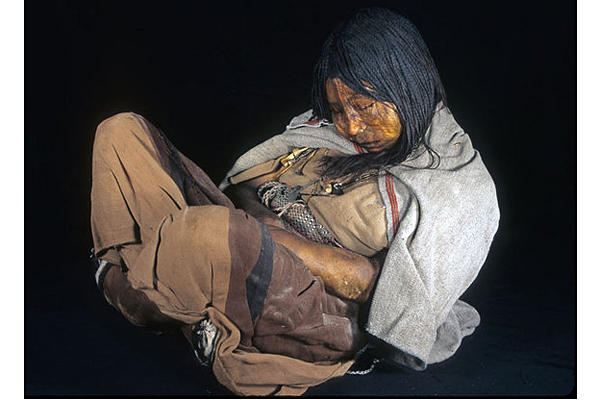We reach more than 65,000 registered users in Dec!! Register Now

Study explores how Inca kids were drugged for sacrifice
- April 29, 2014
- 790 Views
- 0 Likes
- 0 Comment
Chil≠dren of the an≠cient In≠ca Em≠pire were fed in≠ten≠si≠fying doses of al≠co≠hol and co≠ca leaf for as long as a year be≠fore their slaugh≠ter in a bru≠tal sac≠ri≠fice rit≠u≠al, sci≠en≠tists re≠port. Both drugs may have been used for their "psy≠cho≠logic≠ally dead≠en≠ing, dis≠ori≠ent≠ing, and mood-modifying ef≠fects" and to en≠sure co≠op≠er≠a≠tive≠ness, wrote the ...
Chil≠dren of the an¬≠cient In¬≠ca Em¬≠pire were fed in¬≠ten¬≠si¬≠fying doses of al¬≠co¬≠hol and co¬≠ca leaf for as long as a year be¬≠fore their slaugh¬≠ter in a bru¬≠tal sac¬≠ri¬≠fice rit¬≠u¬≠al, sci¬≠en¬≠tists re¬≠port.
Both drugs may have been used for their ‚Äúpsy¬≠cho¬≠logic¬≠ally dead¬≠en¬≠ing, dis¬≠ori¬≠ent¬≠ing, and mood-modifying ef¬≠fects‚ÄĚ and to en¬≠sure co¬≠op¬≠er¬≠a¬≠tive¬≠ness, wrote the re¬≠search¬≠ers. Their pa¬≠pe¬≠r appeared on the on¬≠line is¬≠sue of the jour¬≠nal¬†Pro¬≠ceed¬≠ings of the Na¬≠tio¬≠n¬≠al Aca¬≠de¬≠my of Sci¬≠en¬≠ces.
More¬≠o¬≠ver, ‚Äúco¬≠ca and al¬≠co¬≠hol were sub¬≠stances that in¬≠duced al¬≠tered states in¬≠ter¬≠preted as sa¬≠cred, and which could sug¬≠gest to vic¬≠tims and those as¬≠so¬≠ci¬≠at¬≠ed with them the proxim¬≠ity of the di¬≠vine be¬≠ings‚ÄĚ whom the sac¬≠ri¬≠fices were meant to ap¬≠pease, they added.
Co­ca, a plant from which the drug co­caine is de­rived, was in wide­spread use in the In­ca Em­pire, which lasted from about the 12th to the 16th cen­turies A.D. and was based in modern-day Pe­ru.
More than a dec­ade ago, ar­chae­o­lo­gists un­earthed three in­di­vid­ually en­tombed mum­mies pe­rched atop Llul­lail­laco, a 6,739 me­ter (7,370 yard) high An­de­an vol­ca­no in north­west Ar­gen­ti­na. Long be­lieved to be sac­ri­ficed dur­ing cer­e­mo­ni­al In­ca rites called ca­pa­cocha, the 13-year-old girl, and 4-5-year-old boy and girl were re­markably well-pre­served and have since been ex­ten­sively stud­ied.
An­drew Wil­son of the Uni­vers­ity of Brad­ford, U.K., tracked the chil­dren's con­sump­tion of co­ca leaves and an al­co­holic bev­er­age called chi­cha by check­ing the lev­els of co­ca and chi­cha chem­i­cal break­down prod­ucts in the mum­mies' hair. This pro­cess is not un­like stu­dy­ing tree rings. Hair clos­er to the root is more re­cently grown and thus tends to con­tain chem­i­cals re­flect­ing the most re­cent di­e­tary habits.
For the ‚Äúmaid¬≠en,‚ÄĚ the re¬≠search¬≠ers were able to trace di¬≠et over the 21 months be¬≠fore death. It ap¬≠pears she con¬≠sumed more co¬≠ca and chi¬≠cha than the two oth¬≠er chil¬≠dren, they found. The da¬≠ta in¬≠di¬≠cate an ir¬≠reg¬≠u¬≠lar but strong, overall, in¬≠crease in in¬≠take of both sub¬≠stances over the year be¬≠fore death, Wil¬≠son and col¬≠leagues found. Al¬≠co¬≠hol use in par¬≠tic¬≠u¬≠lar spiked sharply just be¬≠fore death.
The maid­en was con­sum­ing co­ca right un­til the end, with a chewed-up bun­dle of co­ca leaves still be­tween her teeth, the sci­en­tists not­ed.
The consumption patterns may re¬≠flect ‚Äúan in¬≠ten¬≠tion¬≠al and pre¬≠cise sched¬≠ule of events,‚ÄĚ Wil¬≠son and col¬≠leagues wrote. The young¬≠er chil¬≠dren had much shorter hair than the maid¬≠en and thus their da¬≠ta went back only about a third as far-the re¬≠search¬≠ers as¬≠sumed hair growth of 1 cm (0.4 inches) per month.
The ca­pa­cocha rit­u­al, held in hon­or of im­por­tant impe­rial events, un­folded with the In­ca send­ing a de­mand for trib­ute out to the provinces, in­clud­ing for phys­ic­ally pe­rfect 4-to-16-year-old chil­dren. These would be sac­ri­ficed amid much cer­e­mo­ny and feast­ing in their hon­or. Death might oc­cur by suf­foca­t­ion, a head b­low or bur­i­al alive; in any case, the vic­tims would be left bur­ied in an elab­o­rate moun­tain­top gra­ve.
The rit¬≠u¬≠al would in¬≠evitably have cre¬≠at¬≠ed a ‚Äúcli¬≠mate of fear‚ÄĚ among sub¬≠ject peo¬≠ples of the In¬≠ca Em¬≠pire, Wil¬≠son and col¬≠leagues wrote, al¬≠though elab¬≠o¬≠rate pre¬≠tenses typ¬≠ic¬≠ally masked this fear.
‚ÄúThis is im¬≠plic¬≠it in com¬≠ments made by the Span¬≠ish Jes¬≠u¬≠it mis¬≠sion¬≠ary and writ¬≠er Bern¬≠ab√© Cobo (1653) in rela¬≠t¬≠ion to par¬≠ents com¬≠pelled to give up their chil¬≠dren,‚ÄĚ they added. Cobo wrote that ‚Äú¬Ďit was a ma¬≠jor of¬≠fense to show any sad¬≠ness,' and that ¬Ďthey were obliged to do it with ges¬≠tures of hap¬≠pi¬≠ness and sat¬≠is¬≠fac¬≠tion, as if they were tak¬≠ing their chil¬≠dren to be¬≠stow up¬≠on them a ver¬≠y im¬≠por¬≠tant re¬≠ward.'‚ÄĚ
![10413[1]](http://machprinciple.com/wp-content/uploads/2014/04/104131.jpg)
Source : http://www.world-science.net
Cite This Article as
No tags found for this post









